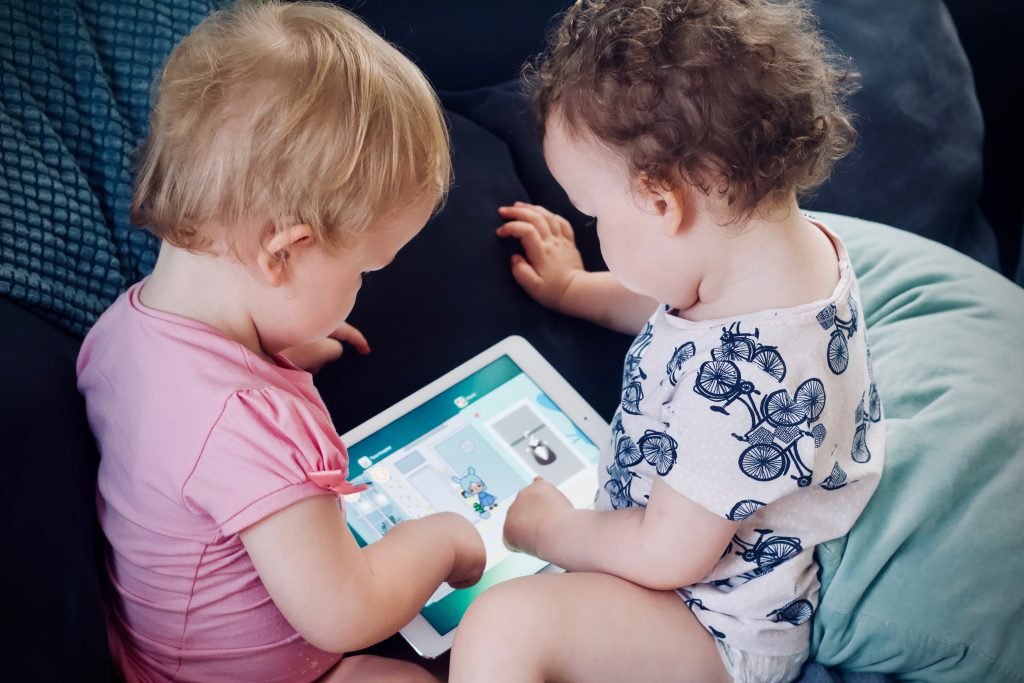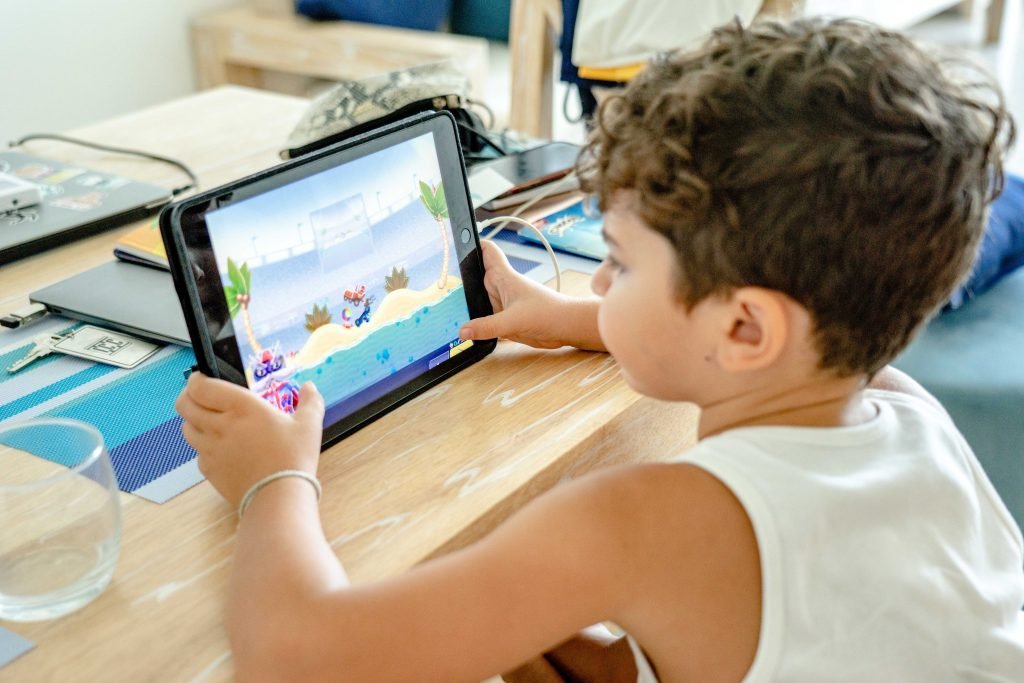These days children are constantly and unavoidably surrounded by screens, from smartphones, smartwatches, and tablets to computers and televisions. No doubt that technology offers numerous benefits and educational opportunities. Parents should try to balance screen time and playtime with traditional toys.
What Is the Recommended Screen Time by Age for Kids?
General guidelines for screen time recommendations by age for children are provided by The American Academy of Pediatrics (AAP) and are listed below:
| Age GroupScreen | Time Recommendation |
|---|---|
| Younger than 18 months | Avoid screen time except for video chatting |
| 18 to 24 months | Limit screen time to a maximum of 1 hour/day |
| 2 to 5 years | Limit screen time to a maximum of 1 hour/day |
| 6 years and older | Establish consistent limits based on family preferences |
The Pros and Cons of Screen Time
Parents must know these pros and cons and make thoughtful decisions regarding their children’s screen time usage. By establishing clear guidelines and prioritizing quality content and interactive experiences, more negative effects can be mitigated, and the benefits of screen time can be maximized.
The Pros of Screen Time
- Educational Content: Screen time can be hugely beneficial as kids can access various educational resources, from interactive learning apps and e-books to educational videos. Children can explore multiple subjects, develop new skills, and expand their knowledge base.
- Cognitive Skills Enhancement: Certain digital games and activities can improve cognitive abilities like problem-solving, critical thinking, and memory skills. These interactive experiences engage children dynamically, stimulating their brains and promoting intellectual growth.
- Technological Literacy: Technological proficiency is increasingly important in today’s digital world. Screen time allows children to familiarize themselves with digital interfaces, operating systems, and tools, equipping them with valuable skills for future endeavors.
- Creativity and Expression: Technology offers platforms for creative expression, such as digital art apps and storytelling tools. Children can explore their artistic abilities, experiment with multimedia content, and share their creations with others.
The Cons of Screen Time
- Sedentary Lifestyle: Excessive screen time often leads to a sedentary lifestyle, reducing physical activity levels. Prolonged sitting and lack of physical movement can contribute to health issues like obesity, poor posture, and muscular weaknesses.
- Impaired Social Development: Spending excessive time in front of screens may hinder the development of social skills and interpersonal relationships best nurtured through real-life experiences and interactions.
- Sleep Disruptions: The blue light emitted by screens can disrupt sleep patterns, especially when used close to bedtime. This interference can lead to difficulties falling asleep, poorer sleep quality, and daytime fatigue, affecting overall well-being and cognitive performance.
- Content Quality and Exposure: Not all screen content suits or benefits children. Especially be aware of any inappropriate or violent content your kids may be exposed to. Young children are easily influenced, negatively affecting their behavior, emotions, and psychological well-being. Parental supervision and guidance are crucial to ensuring age-appropriate and positive screen experiences.
- Overstimulation and Attention Issues: Rapidly changing visuals, sounds, and constant notifications on screens can overstimulate young children’s brains. This overstimulation may lead to attention issues, difficulty focusing, and difficulty regulating emotions and impulses.

The Importance of Playtime with Traditional Toys
Traditional toys offer unique benefits to playtime, such as building blocks, puzzles, dolls, and board games.
Promoting Creativity and Imagination
Traditional toys provide open-ended play experiences encouraging children to unleash their creativity and imagination. Building blocks can be transformed into towering castles or imaginary cities, while dolls become characters in intricate storylines. Engaging in unstructured play teaches children to think outside the box, experiment with different scenarios, and develop their narratives.
Enhancing Cognitive Skills
Traditional toys stimulate cognitive development in various ways. Puzzles, for example, improve problem-solving abilities, spatial awareness, and logical thinking. Children manipulate puzzle pieces and learn to analyze shapes, colors, and patterns. Board games introduce rules, turn-taking, and strategic thinking, fostering critical thinking and decision-making skills.
Developing Fine Motor Skills
Manipulating traditional toys helps develop fine motor skills and hand-eye coordination. From stacking blocks to fitting puzzle pieces together, children refine their motor skills and talent, setting the stage for future activities such as writing, drawing, and playing musical instruments.
Encouraging Social Interaction
Traditional toys provide opportunities for children to engage in cooperative play and social interactions. Board games and pretend play with dolls or action figures promote communication, sharing, negotiation, and collaboration. These interactions build important social skills, empathy, and the ability to navigate social dynamics.
Emotional Development
Traditional toys can be tools for emotional expression and regulation. Dolls, for example, allow children to role-play and explore different emotions, helping them understand and manage their feelings. Playing with toys also offers a safe space for children to process and express their experiences, fears, and aspirations.
Screen-Free Break
Playtime with traditional toys offers a much-needed break from screens and digital devices. It provides a tangible and sensory experience, allowing children to engage with physical objects and their immediate environment. This break from screens promotes a healthy balance, reduces overstimulation, and encourages children to explore their surroundings.

Striking a Balance – Integrating Technology and Traditional Toys
Finding a balance between technology and traditional toys is essential in today’s digital age. Both have unique benefits and play a valuable role in children’s development.
- Set Screen Time Limits: Establish clear guidelines for screen time, ensuring that it doesn’t overshadow playtime with traditional toys. Set specific time limits for different activities, such as educational apps or entertainment content, and communicate these boundaries to your children. Consistency and parental involvement in monitoring screen time are key to maintaining a healthy balance.
- Select Age-Appropriate Apps and Games: Choose educational apps and games that align with your child’s age, interests, and learning goals. Many useful apps would help to develop problem-solving, creativity, and critical thinking skills. Prioritize apps that encourage active participation rather than passive consumption. Seek out trusted educational resources and read reviews to ensure the content is safe, engaging, and aligned with your child’s developmental needs.
- Incorporate Educational Content: Use technology to supplement learning and engage children in educational activities. Many educational websites, interactive learning platforms, and digital libraries offer valuable content that complements traditional toys. Explore resources focusing on STEM subjects, language development, art, music, and other areas of interest.
- Create Dedicated Play Spaces: Designate specific areas in your home for playtime with traditional toys. Set up shelves or storage units to organize and display the toys, making them easily accessible to your children. Creating an inviting and dedicated play space encourages children to engage with their toys and promotes independent play.
- Rotate Toys and Activities: Keep playtime fresh and exciting by regularly rotating toys and activities. Introduce new traditional toys and rotate them with technology-based play. This approach allows children to experience a variety of play experiences, stimulating their curiosity and preventing screen time from becoming monotonous.
- Engage in Co-play: Actively engage with your child during screen time and playtime with traditional toys by asking them questions and discussing their learning while playing. During traditional toy play, join their imaginative play scenarios, build together, or play board games as a family. Co-play strengthens the parent-child bond and provides opportunities for teaching, modeling, and reinforcing social skills.
- Encourage Offline Exploration: Balance screen time with real-world exploration and hands-on activities. Encourage outdoor play, nature walks, museum visits, and physical activities such as sports or arts and crafts. These activities expand children’s horizons, promote physical health, and nurture creativity outside the digital realm.
- Be a Role Model: Children learn by observing their parents’ behaviors. Set a positive example by modeling a healthy balance between technology and traditional toys. Limit your screen time, engage in offline activities, and demonstrate enthusiasm for traditional play experiences. Your active participation will inspire your children to follow suit.
Engaging Discussions – Navigating Challenges and Concerns
When balancing technology and traditional toys, parents often encounter challenges and concerns. Engaging in discussions and addressing these issues is crucial for creating a healthy and balanced play environment for children.
Resistance to Traditional Toys
Some children may resist playing with traditional toys, mainly if they are accustomed to screen-based activities. To overcome this challenge, introduce traditional toys gradually and make the play experience enjoyable. Sit down and play alongside your child, demonstrating conventional toys’ fun and creative possibilities. Encourage open-ended play and provide positive reinforcement when they engage with the toys.
Managing Screen Time during Vacations and Weekends
Vacations and weekends often provide more free time, which can lead to increased screen time. To manage this, establish clear boundaries and communicate expectations. Plan alternative activities that involve traditional toys, such as family outings, arts and crafts projects, or board game nights. Engage children in decision-making by letting them choose activities they enjoy, reducing their reliance on screens during leisure time.
Addressing Safety Concerns
With technology, parents have valid concerns about online safety, privacy, and exposure to inappropriate content. Openly discuss these concerns with your children, emphasizing the importance of responsible digital behavior and online safety. Set up parental controls and age-appropriate content filters on devices to minimize risks. Additionally, actively engage in your child’s digital activities, familiarizing yourself with the apps, games, and websites they use to ensure they are safe and appropriate.
Fostering Open Communication
Encourage open and ongoing communication with your children about technology use. Establish an environment where they feel comfortable discussing their experiences, challenges, and questions about screens and traditional toys. Listen to their perspectives, validate their feelings, and provide guidance and support. You can address concerns, reinforce healthy habits, and promote responsible technology use by fostering open communication.
Promoting Digital Literacy and Critical Thinking
Educate your children about technology’s potential pitfalls and challenges. Teach them to evaluate online content critically, distinguish between reliable and unreliable sources, and be mindful of their online presence. Instilling digital literacy skills empowers children to make informed decisions, be responsible digital citizens, and navigate the digital landscape safely and responsibly.
Balancing Quality Content and Entertainment
Not all screen time is created equal. Motivate your children to engage with high-quality educational content, apps, and games that align with their interests and developmental needs. Guide them in selecting content that promotes learning, creativity, problem-solving, and critical thinking. Balance educational screen time with recreational activities that offer entertainment and relaxation without relying solely on screens.
Emphasizing Real-World Experiences
While screens provide virtual experiences, it’s essential to emphasize real-world experiences and hands-on learning, such as exploring their surroundings, being physically active, pursuing hobbies, and interacting face-to-face. This helps broaden their horizons, develop social skills, and cultivate a well-rounded personality beyond the digital realm.
Adapting to Age and Developmental Needs
Recognize that the balance between technology and traditional toys may vary based on your child’s age and developmental stage. Younger children may benefit from more hands-on play experiences, while older children may require technology for educational purposes or digital skills development. Continuously assess and adapt your approach to ensure it aligns with your child’s evolving needs.

Implementing a Family Playtime Routine
Implementing a family playtime routine is a valuable strategy to ensure a balanced and enjoyable play experience for children and parents. Establishing a routine sets clear expectations and creates dedicated time for quality interactions, bonding, and shared experiences.
Here are some steps to help you make an effective family playtime routine:
- Identify Playtime Goals: Begin by identifying the goals you have for family playtime. Consider the desired outcomes, such as fostering creativity, promoting social interaction, learning together, or simply having fun. Understanding your objectives will guide the activities you choose and the structure of your routine.
- Determine a Regular Schedule: Consistency is key when establishing a routine. Decide on a regular schedule for family playtime that works for your family’s dynamics and commitments. Consider time slots that are convenient and realistic for everyone involved, such as after dinner, weekend mornings, or dedicated family game nights. Consistency in scheduling helps children anticipate and look forward to these special moments.
- Allocate Dedicated Play Spaces: Designate specific areas in your home for family playtime. Create a play corner, set up a playroom, or utilize a shared living space for play activities. Organize and display toys, games, and materials in an accessible and inviting manner. Having dedicated play spaces helps create an environment that encourages play and reinforces the importance of this designated time.
- Select a Variety of Activities: Keep the playtime engaging and diverse by selecting various activities that cater to different interests and developmental needs. Include a mix of traditional toys, technology-based games, interactive storytelling, arts and crafts, outdoor play, and board games. This variety ensures that each family member can participate and enjoy the playtime experience.
- Involve Everyone: Family playtime allows quality bonding and shared experiences for all family members. Engage in cooperative play, take turns, and collaborate on projects or games. Involving everyone creates a sense of togetherness and strengthens family connections.
- Rotate Roles and Activities: To keep playtime fresh and exciting, rotate roles and activities among family members. Take turns being the game master, storyteller, or the leader of an activity. This promotes creativity and imagination and ensures that everyone can engage in activities they enjoy. It also encourages cooperative play and helps children develop empathy and teamwork skills.
- Incorporate Digital and Offline Play: Strive for a balanced approach by incorporating digital and offline play activities into your routine. Set aside time slots for screen-based activities that align with educational goals or family entertainment. Similarly, dedicate time for traditional toy play, outdoor exploration, or creative projects. This balance allows children to experience the benefits of technology and hands-on play.
- Maintain Parental Involvement: Actively participate in family playtime as a parent. Share your own experiences, and create cherished memories. Your involvement not only enhances the quality of playtime but also models active participation and promotes parent-child bonding.
- Adapt and Evolve: Be flexible and willing to adapt the routine as your children grow and their interests change. Keep an open dialogue with your children, listen to their input, and incorporate their ideas into the routine. As they age, the activities and dynamics of family playtime may need adjustments to suit their evolving needs and preferences.
Implementing a family playtime routine creates dedicated time for shared experiences, learning, and fun. This routine fosters stronger family connections, promotes social and cognitive development, and establishes healthy play habits.
A Final Thought
In the digital era, balancing screen time and playtime with traditional toys is a challenge many parents face. Striving for a healthy balance allows children to reap the benefits of educational technology while nurturing their creativity, social skills, and cognitive development through hands-on play.